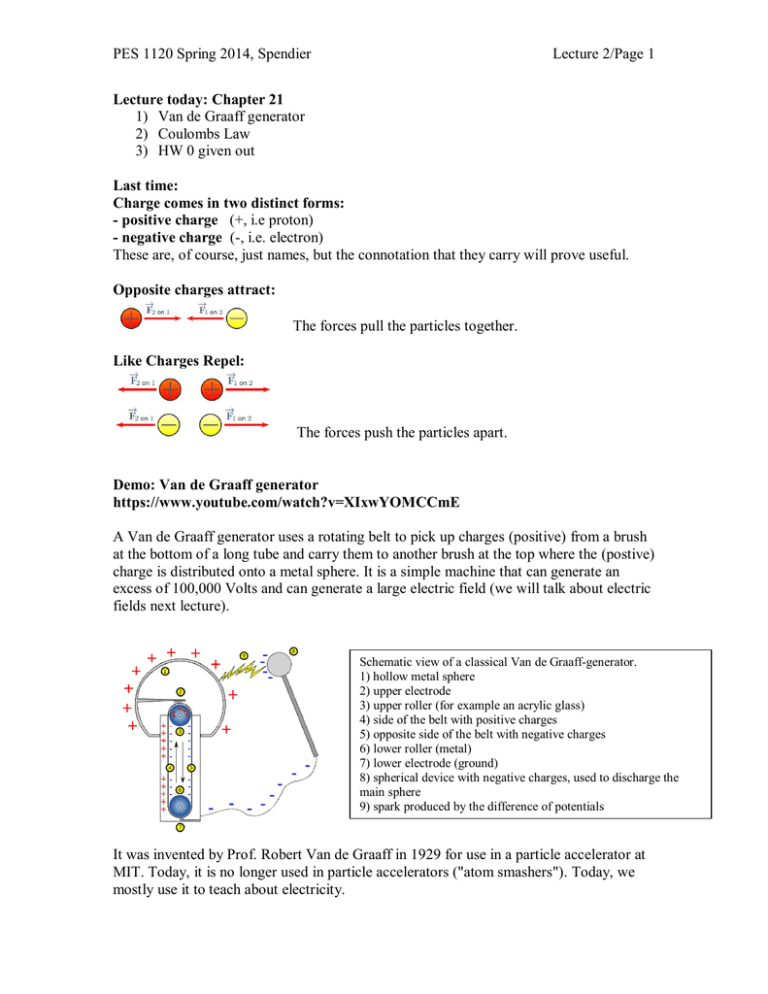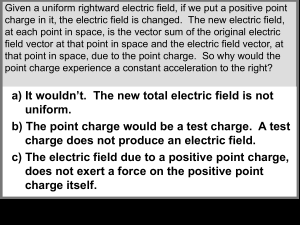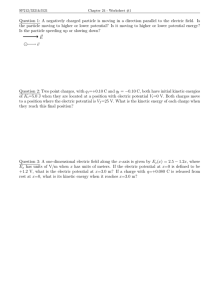PES 1120 Spring 2014, Spendier Lecture 2/Page 1 Lecture today
advertisement

PES 1120 Spring 2014, Spendier Lecture 2/Page 1 Lecture today: Chapter 21 1) Van de Graaff generator 2) Coulombs Law 3) HW 0 given out Last time: Charge comes in two distinct forms: - positive charge (+, i.e proton) - negative charge (-, i.e. electron) These are, of course, just names, but the connotation that they carry will prove useful. Opposite charges attract: The forces pull the particles together. Like Charges Repel: The forces push the particles apart. Demo: Van de Graaff generator https://www.youtube.com/watch?v=XIxwYOMCCmE A Van de Graaff generator uses a rotating belt to pick up charges (positive) from a brush at the bottom of a long tube and carry them to another brush at the top where the (postive) charge is distributed onto a metal sphere. It is a simple machine that can generate an excess of 100,000 Volts and can generate a large electric field (we will talk about electric fields next lecture). Schematic view of a classical Van de Graaff-generator. 1) hollow metal sphere 2) upper electrode 3) upper roller (for example an acrylic glass) 4) side of the belt with positive charges 5) opposite side of the belt with negative charges 6) lower roller (metal) 7) lower electrode (ground) 8) spherical device with negative charges, used to discharge the main sphere 9) spark produced by the difference of potentials It was invented by Prof. Robert Van de Graaff in 1929 for use in a particle accelerator at MIT. Today, it is no longer used in particle accelerators ("atom smashers"). Today, we mostly use it to teach about electricity. PES 1120 Spring 2014, Spendier Lecture 2/Page 2 The largest air-insulated Van de Graaff generator in the world, built by Dr. Van de Graaff in the 1930s, is now on permanent display at Boston's Museum of Science. With two conjoined 4.5 meter (15 foot) aluminum spheres standing on columns 22 feet (6.7 m) tall, this generator can often reach 2 MV (2 millionvolts). Demos: 1) Showed the electric discharge from Van de Graff generator to a nearby grounded rod 2) Showed the hair stands up like charges repel! 3) Laid a stack of aluminum pie plates on the generator and turn it on. The plates will rose off one at a time by electrostatic repulsion as if they were an armada of UFOs. What's happening is that the top pan picks up a charge and is repulsed by the generator and the pans under it. It is clear from the demos that there is a force between charges. What force law dictates the behavior of electric charges? It looks like the further away two charges are the smaller the force acting between them. In Physics 1 we talked about the gravitational force between two masses: Gm1 m2 Fg r2 The force that dictates the behavior of eclectic charges is very similar to this force law. G = gravitational constant m1 = mass of object 1 m2 = mass of object 2 r = separation distance, distance between m1 and m2 Coulomb's Law Coulomb’s Law (Charles-Augustin de Coulomb, 1785) gives the magnitude of the electric force between point charges Point Charges - Objects with charge and mass but negligible size q1 - Charge in Coulombs of first object [C] q2 - Charge in Coulombs of second object [C] r - Separation distance [m] k - Electrostatic Constant, k = 8.99 x 109 Nm2/C2 PES 1120 Spring 2014, Spendier Lecture 2/Page 3 Coulomb’s Law (Inverse square law) k q1 q2 Magnitude: F12 F21 units [N] = [kg m s-2] 2 r F12 is the magnitude of the force on particle 1 due to the presence of particle 2 F21 is the magnitude of the force on particle 2 due to the presence of particle 1 1 Later we’ll find it more convenient to set k where ε0 = 8.854 x 10-12 M-1 m-2C2 is 4 0 another constant called the "permittivity of free space" Things you need to do when you solve a problem - Draw a diagram - convert quantities to SI units - write down the equation/s you need to use - clearly state your reasoning and/or assumptions - rearrange and simplify equations when needed, then plug in numbers - remember vectors - they have both magnitude an direction - the number of significant figures in the result should be equal to the number of significant digits in the least precise number (the number with the fewest significant digits given in the problem). Example 1: A particle of charge + 3.00 μC is 12.0 cm distant from a second particle of charge -1.50 μC. Calculate the magnitude of the electrostatic force between the particles. PES 1120 Spring 2014, Spendier Lecture 2/Page 4 Example 2: A nucleus has a radius of about 4.0 x 10-15 m and contains 2 protons. a) What is the magnitude of the repulsive electrostatic force between the two protons if they are separated by 4.0 x 10-15 m? b) If the force in a) where unbalanced, what would be the acceleration of a protons? c) We know that the nucleus is stable, i.e. it does not explode. Could it be that the attractive gravitational force between the two protons balances the electrostatic repulsion? What is the magnitude of the gravitational force between those same two protons? PES 1120 Spring 2014, Spendier Lecture 2/Page 5 Weak versus strong: This result tells us that the (attractive) gravitational force is far too weak to counter the repulsive electrostatic forces between protons in a nucleus. Instead, the protons are bound together by an enormous force called (aptly) the strong nuclear force—a force that acts between protons (and neutrons) when they are close together, as in a nucleus. Direction: Depending on the charges, the electric force is either attractive or repulsive. In either case, the angle of the force is along the line connecting the charges. For a positive and a negative charge: F12 - Force on particle 1 due to presence of particle 2 F21 - Force on particle 2 due to presence of particle 1 Geometry determines direction Coulomb’s Law in vector form: qq F k 1 2 2 rˆ r r̂ .... unit vector If the particles have the same signs of charge, the force on particle 1 is in the direction of r̂ ; if they have opposite signs, the force is opposite r̂ . Multiple forces: As with all forces we covered in Physics 1, the electrostatic force obeys the principle of superposition (remember - need to add components of vectors) Suppose we have n charged particles near a chosen particle called particle 1, then the net force on particle 1 is given by the vector sum F1, net F12 F13 F14 F15 .... F1n for example F14 is the force on particle 1 due to the presence of particle 4 PES 1120 Spring 2014, Spendier Lecture 2/Page 6 Example 3: Three point charges are all in line as shown. If the net force on q2 is zero, how much charge does q3 have?






